Applied Corporate Strategy: Zara Online Strategy Report
VerifiedAdded on 2022/08/15
|19
|4403
|72
Report
AI Summary
This report provides a comprehensive analysis of Zara's online strategy, examining its external environment using PESTEL and Porter's Five Forces, and its internal capabilities through the VRIO framework. The analysis identifies opportunities and threats, assesses industry attractiveness, and evaluates Zara's resources and core competencies. The report further delves into a strategic evaluation of a recent strategy implemented by Zara using the SAF test. The report also includes an introduction, resources, and capabilities, and a conclusion that summarizes the key findings and implications for Zara's strategic direction within the fast-fashion industry. The report evaluates Zara's online strategy and its ability to adapt to changing consumer preferences and market dynamics.
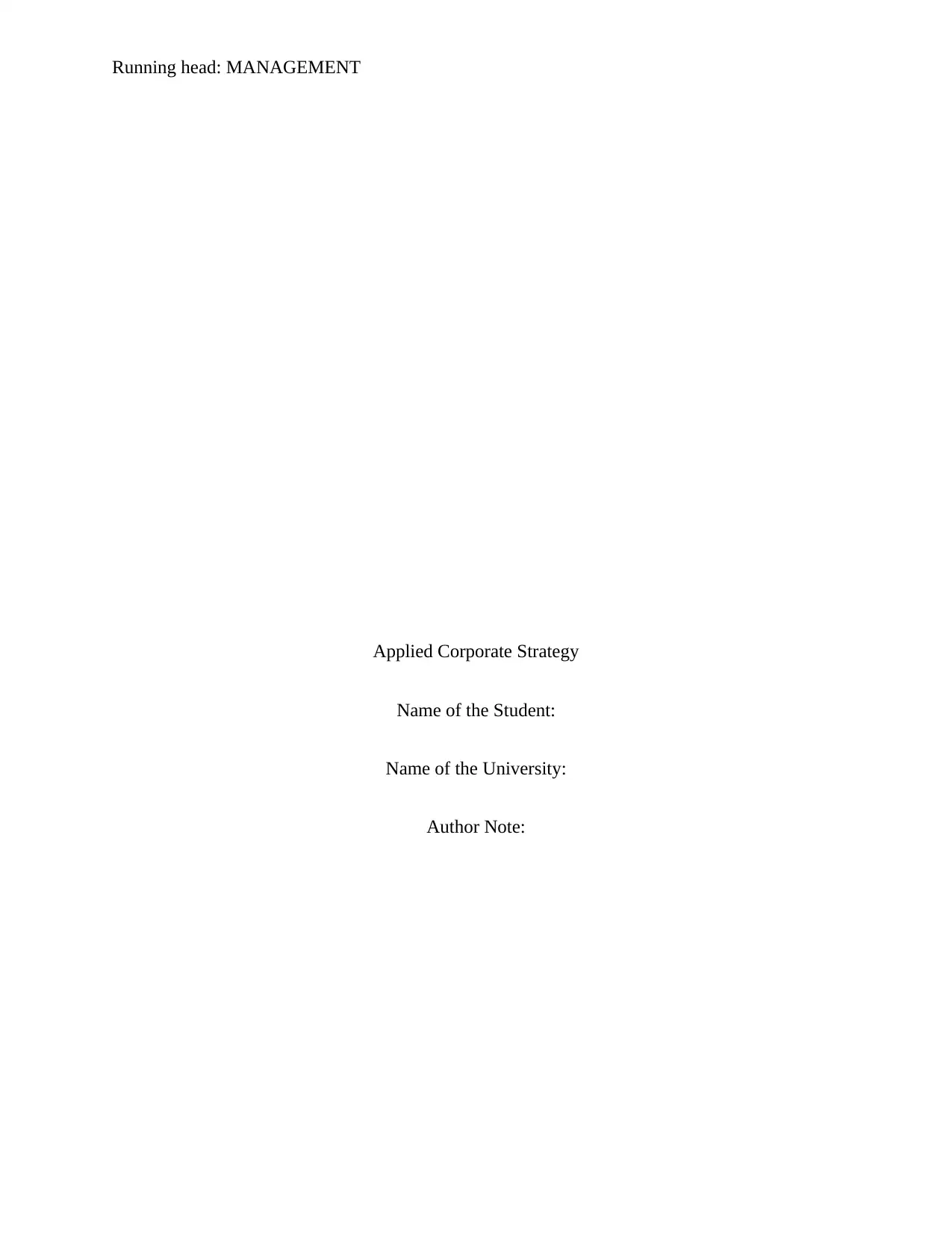
Running head: MANAGEMENT
Applied Corporate Strategy
Name of the Student:
Name of the University:
Author Note:
Applied Corporate Strategy
Name of the Student:
Name of the University:
Author Note:
Paraphrase This Document
Need a fresh take? Get an instant paraphrase of this document with our AI Paraphraser
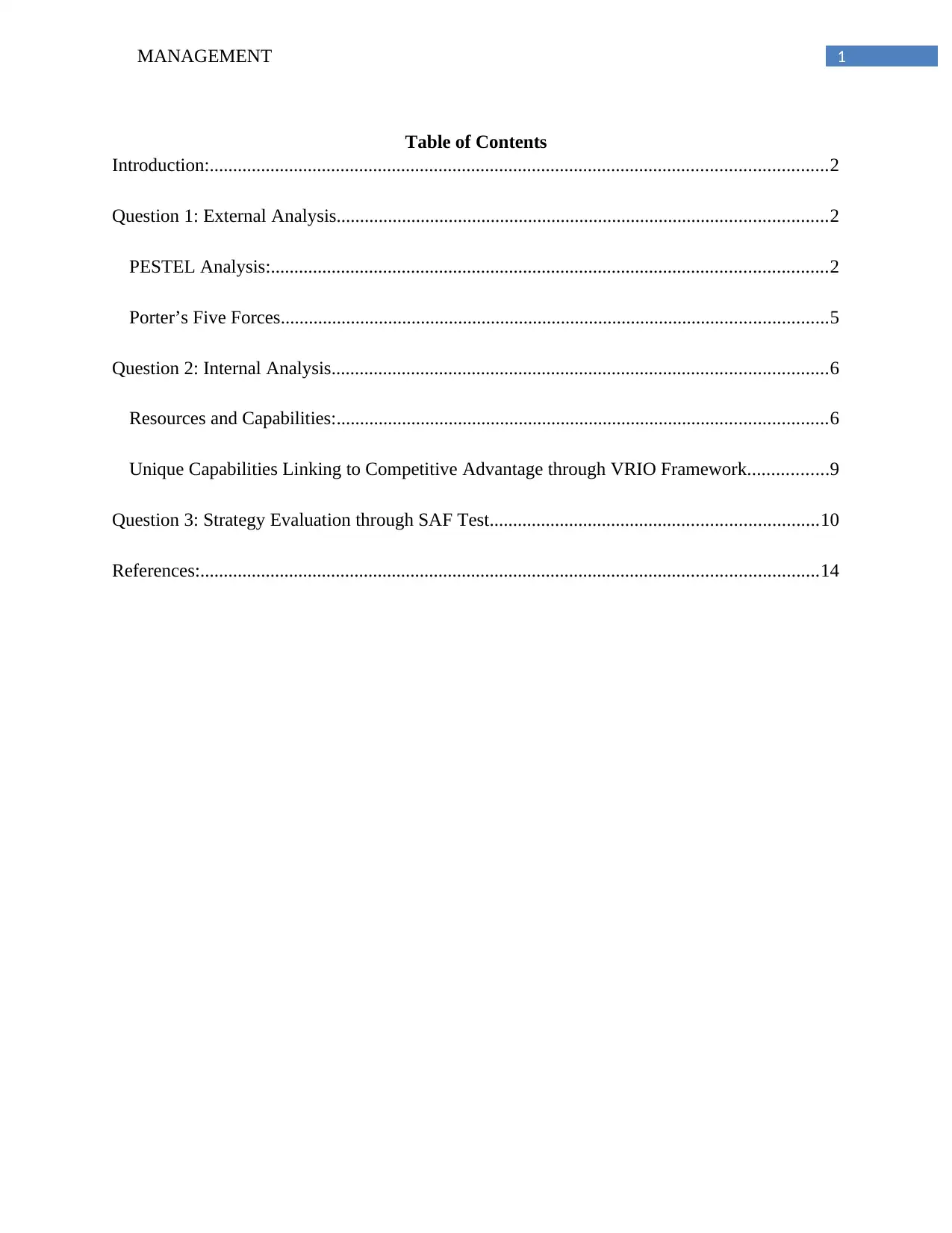
1MANAGEMENT
Table of Contents
Introduction:....................................................................................................................................2
Question 1: External Analysis.........................................................................................................2
PESTEL Analysis:.......................................................................................................................2
Porter’s Five Forces.....................................................................................................................5
Question 2: Internal Analysis..........................................................................................................6
Resources and Capabilities:.........................................................................................................6
Unique Capabilities Linking to Competitive Advantage through VRIO Framework.................9
Question 3: Strategy Evaluation through SAF Test......................................................................10
References:....................................................................................................................................14
Table of Contents
Introduction:....................................................................................................................................2
Question 1: External Analysis.........................................................................................................2
PESTEL Analysis:.......................................................................................................................2
Porter’s Five Forces.....................................................................................................................5
Question 2: Internal Analysis..........................................................................................................6
Resources and Capabilities:.........................................................................................................6
Unique Capabilities Linking to Competitive Advantage through VRIO Framework.................9
Question 3: Strategy Evaluation through SAF Test......................................................................10
References:....................................................................................................................................14
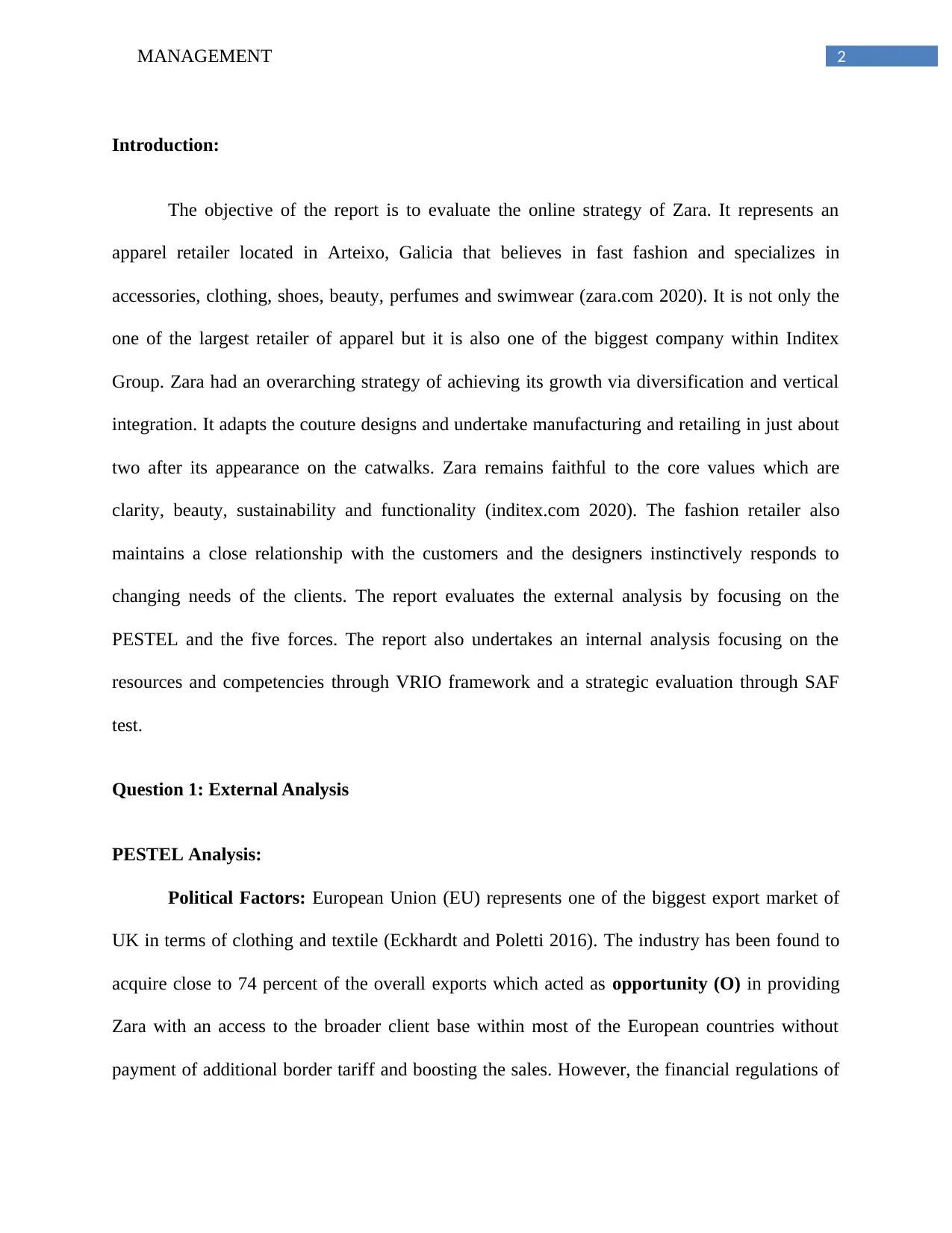
2MANAGEMENT
Introduction:
The objective of the report is to evaluate the online strategy of Zara. It represents an
apparel retailer located in Arteixo, Galicia that believes in fast fashion and specializes in
accessories, clothing, shoes, beauty, perfumes and swimwear (zara.com 2020). It is not only the
one of the largest retailer of apparel but it is also one of the biggest company within Inditex
Group. Zara had an overarching strategy of achieving its growth via diversification and vertical
integration. It adapts the couture designs and undertake manufacturing and retailing in just about
two after its appearance on the catwalks. Zara remains faithful to the core values which are
clarity, beauty, sustainability and functionality (inditex.com 2020). The fashion retailer also
maintains a close relationship with the customers and the designers instinctively responds to
changing needs of the clients. The report evaluates the external analysis by focusing on the
PESTEL and the five forces. The report also undertakes an internal analysis focusing on the
resources and competencies through VRIO framework and a strategic evaluation through SAF
test.
Question 1: External Analysis
PESTEL Analysis:
Political Factors: European Union (EU) represents one of the biggest export market of
UK in terms of clothing and textile (Eckhardt and Poletti 2016). The industry has been found to
acquire close to 74 percent of the overall exports which acted as opportunity (O) in providing
Zara with an access to the broader client base within most of the European countries without
payment of additional border tariff and boosting the sales. However, the financial regulations of
Introduction:
The objective of the report is to evaluate the online strategy of Zara. It represents an
apparel retailer located in Arteixo, Galicia that believes in fast fashion and specializes in
accessories, clothing, shoes, beauty, perfumes and swimwear (zara.com 2020). It is not only the
one of the largest retailer of apparel but it is also one of the biggest company within Inditex
Group. Zara had an overarching strategy of achieving its growth via diversification and vertical
integration. It adapts the couture designs and undertake manufacturing and retailing in just about
two after its appearance on the catwalks. Zara remains faithful to the core values which are
clarity, beauty, sustainability and functionality (inditex.com 2020). The fashion retailer also
maintains a close relationship with the customers and the designers instinctively responds to
changing needs of the clients. The report evaluates the external analysis by focusing on the
PESTEL and the five forces. The report also undertakes an internal analysis focusing on the
resources and competencies through VRIO framework and a strategic evaluation through SAF
test.
Question 1: External Analysis
PESTEL Analysis:
Political Factors: European Union (EU) represents one of the biggest export market of
UK in terms of clothing and textile (Eckhardt and Poletti 2016). The industry has been found to
acquire close to 74 percent of the overall exports which acted as opportunity (O) in providing
Zara with an access to the broader client base within most of the European countries without
payment of additional border tariff and boosting the sales. However, the financial regulations of
⊘ This is a preview!⊘
Do you want full access?
Subscribe today to unlock all pages.

Trusted by 1+ million students worldwide
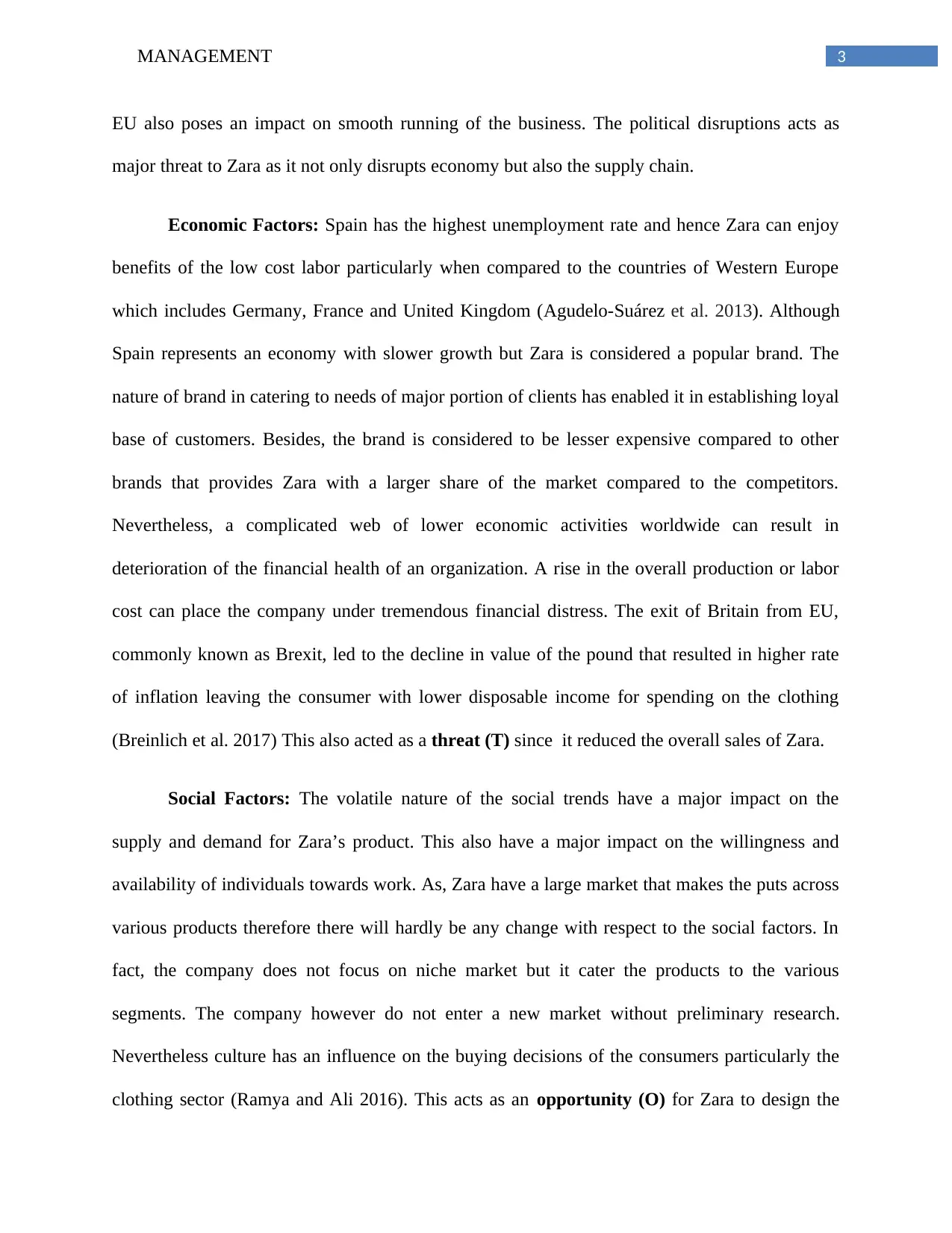
3MANAGEMENT
EU also poses an impact on smooth running of the business. The political disruptions acts as
major threat to Zara as it not only disrupts economy but also the supply chain.
Economic Factors: Spain has the highest unemployment rate and hence Zara can enjoy
benefits of the low cost labor particularly when compared to the countries of Western Europe
which includes Germany, France and United Kingdom (Agudelo-Suárez et al. 2013). Although
Spain represents an economy with slower growth but Zara is considered a popular brand. The
nature of brand in catering to needs of major portion of clients has enabled it in establishing loyal
base of customers. Besides, the brand is considered to be lesser expensive compared to other
brands that provides Zara with a larger share of the market compared to the competitors.
Nevertheless, a complicated web of lower economic activities worldwide can result in
deterioration of the financial health of an organization. A rise in the overall production or labor
cost can place the company under tremendous financial distress. The exit of Britain from EU,
commonly known as Brexit, led to the decline in value of the pound that resulted in higher rate
of inflation leaving the consumer with lower disposable income for spending on the clothing
(Breinlich et al. 2017) This also acted as a threat (T) since it reduced the overall sales of Zara.
Social Factors: The volatile nature of the social trends have a major impact on the
supply and demand for Zara’s product. This also have a major impact on the willingness and
availability of individuals towards work. As, Zara have a large market that makes the puts across
various products therefore there will hardly be any change with respect to the social factors. In
fact, the company does not focus on niche market but it cater the products to the various
segments. The company however do not enter a new market without preliminary research.
Nevertheless culture has an influence on the buying decisions of the consumers particularly the
clothing sector (Ramya and Ali 2016). This acts as an opportunity (O) for Zara to design the
EU also poses an impact on smooth running of the business. The political disruptions acts as
major threat to Zara as it not only disrupts economy but also the supply chain.
Economic Factors: Spain has the highest unemployment rate and hence Zara can enjoy
benefits of the low cost labor particularly when compared to the countries of Western Europe
which includes Germany, France and United Kingdom (Agudelo-Suárez et al. 2013). Although
Spain represents an economy with slower growth but Zara is considered a popular brand. The
nature of brand in catering to needs of major portion of clients has enabled it in establishing loyal
base of customers. Besides, the brand is considered to be lesser expensive compared to other
brands that provides Zara with a larger share of the market compared to the competitors.
Nevertheless, a complicated web of lower economic activities worldwide can result in
deterioration of the financial health of an organization. A rise in the overall production or labor
cost can place the company under tremendous financial distress. The exit of Britain from EU,
commonly known as Brexit, led to the decline in value of the pound that resulted in higher rate
of inflation leaving the consumer with lower disposable income for spending on the clothing
(Breinlich et al. 2017) This also acted as a threat (T) since it reduced the overall sales of Zara.
Social Factors: The volatile nature of the social trends have a major impact on the
supply and demand for Zara’s product. This also have a major impact on the willingness and
availability of individuals towards work. As, Zara have a large market that makes the puts across
various products therefore there will hardly be any change with respect to the social factors. In
fact, the company does not focus on niche market but it cater the products to the various
segments. The company however do not enter a new market without preliminary research.
Nevertheless culture has an influence on the buying decisions of the consumers particularly the
clothing sector (Ramya and Ali 2016). This acts as an opportunity (O) for Zara to design the
Paraphrase This Document
Need a fresh take? Get an instant paraphrase of this document with our AI Paraphraser
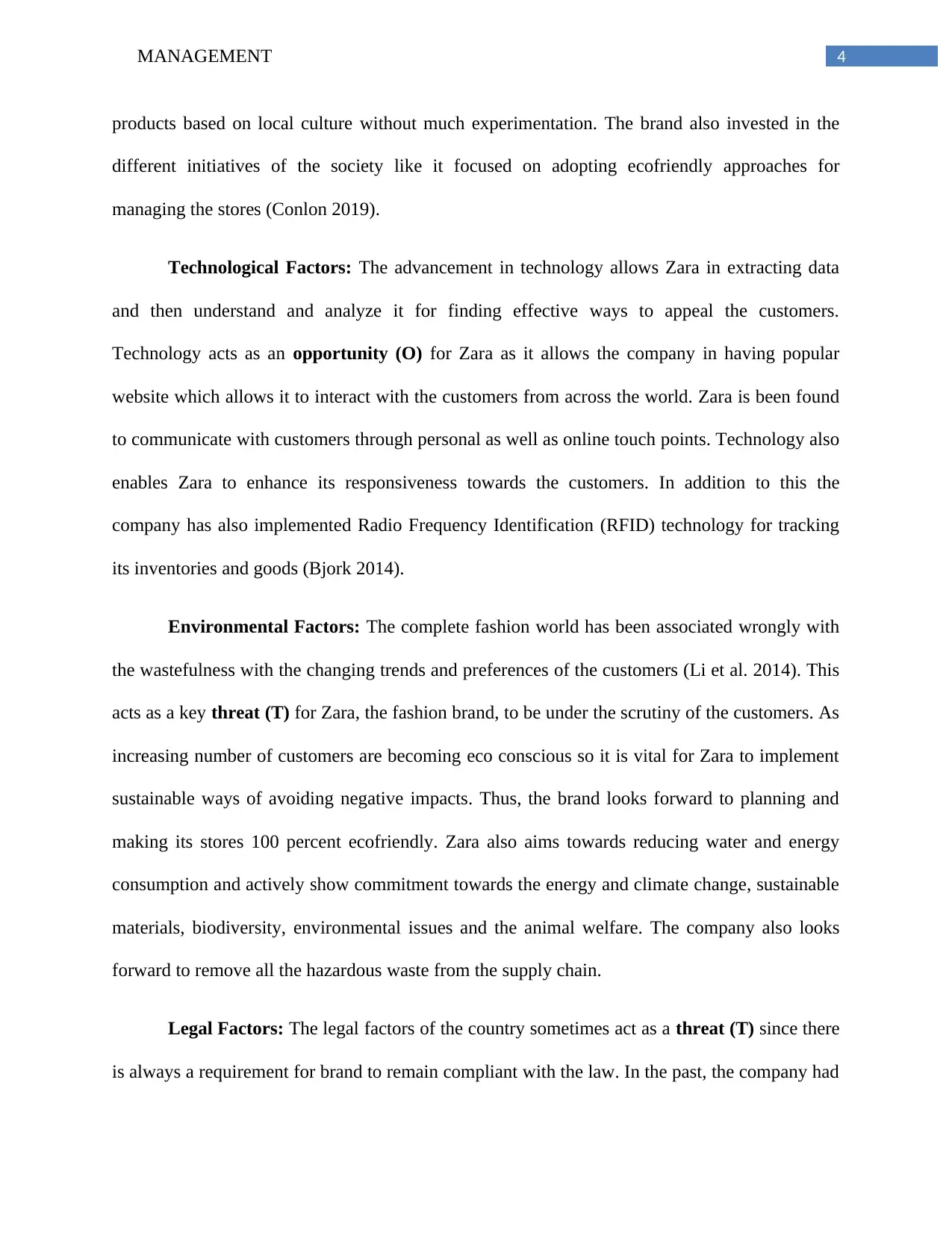
4MANAGEMENT
products based on local culture without much experimentation. The brand also invested in the
different initiatives of the society like it focused on adopting ecofriendly approaches for
managing the stores (Conlon 2019).
Technological Factors: The advancement in technology allows Zara in extracting data
and then understand and analyze it for finding effective ways to appeal the customers.
Technology acts as an opportunity (O) for Zara as it allows the company in having popular
website which allows it to interact with the customers from across the world. Zara is been found
to communicate with customers through personal as well as online touch points. Technology also
enables Zara to enhance its responsiveness towards the customers. In addition to this the
company has also implemented Radio Frequency Identification (RFID) technology for tracking
its inventories and goods (Bjork 2014).
Environmental Factors: The complete fashion world has been associated wrongly with
the wastefulness with the changing trends and preferences of the customers (Li et al. 2014). This
acts as a key threat (T) for Zara, the fashion brand, to be under the scrutiny of the customers. As
increasing number of customers are becoming eco conscious so it is vital for Zara to implement
sustainable ways of avoiding negative impacts. Thus, the brand looks forward to planning and
making its stores 100 percent ecofriendly. Zara also aims towards reducing water and energy
consumption and actively show commitment towards the energy and climate change, sustainable
materials, biodiversity, environmental issues and the animal welfare. The company also looks
forward to remove all the hazardous waste from the supply chain.
Legal Factors: The legal factors of the country sometimes act as a threat (T) since there
is always a requirement for brand to remain compliant with the law. In the past, the company had
products based on local culture without much experimentation. The brand also invested in the
different initiatives of the society like it focused on adopting ecofriendly approaches for
managing the stores (Conlon 2019).
Technological Factors: The advancement in technology allows Zara in extracting data
and then understand and analyze it for finding effective ways to appeal the customers.
Technology acts as an opportunity (O) for Zara as it allows the company in having popular
website which allows it to interact with the customers from across the world. Zara is been found
to communicate with customers through personal as well as online touch points. Technology also
enables Zara to enhance its responsiveness towards the customers. In addition to this the
company has also implemented Radio Frequency Identification (RFID) technology for tracking
its inventories and goods (Bjork 2014).
Environmental Factors: The complete fashion world has been associated wrongly with
the wastefulness with the changing trends and preferences of the customers (Li et al. 2014). This
acts as a key threat (T) for Zara, the fashion brand, to be under the scrutiny of the customers. As
increasing number of customers are becoming eco conscious so it is vital for Zara to implement
sustainable ways of avoiding negative impacts. Thus, the brand looks forward to planning and
making its stores 100 percent ecofriendly. Zara also aims towards reducing water and energy
consumption and actively show commitment towards the energy and climate change, sustainable
materials, biodiversity, environmental issues and the animal welfare. The company also looks
forward to remove all the hazardous waste from the supply chain.
Legal Factors: The legal factors of the country sometimes act as a threat (T) since there
is always a requirement for brand to remain compliant with the law. In the past, the company had
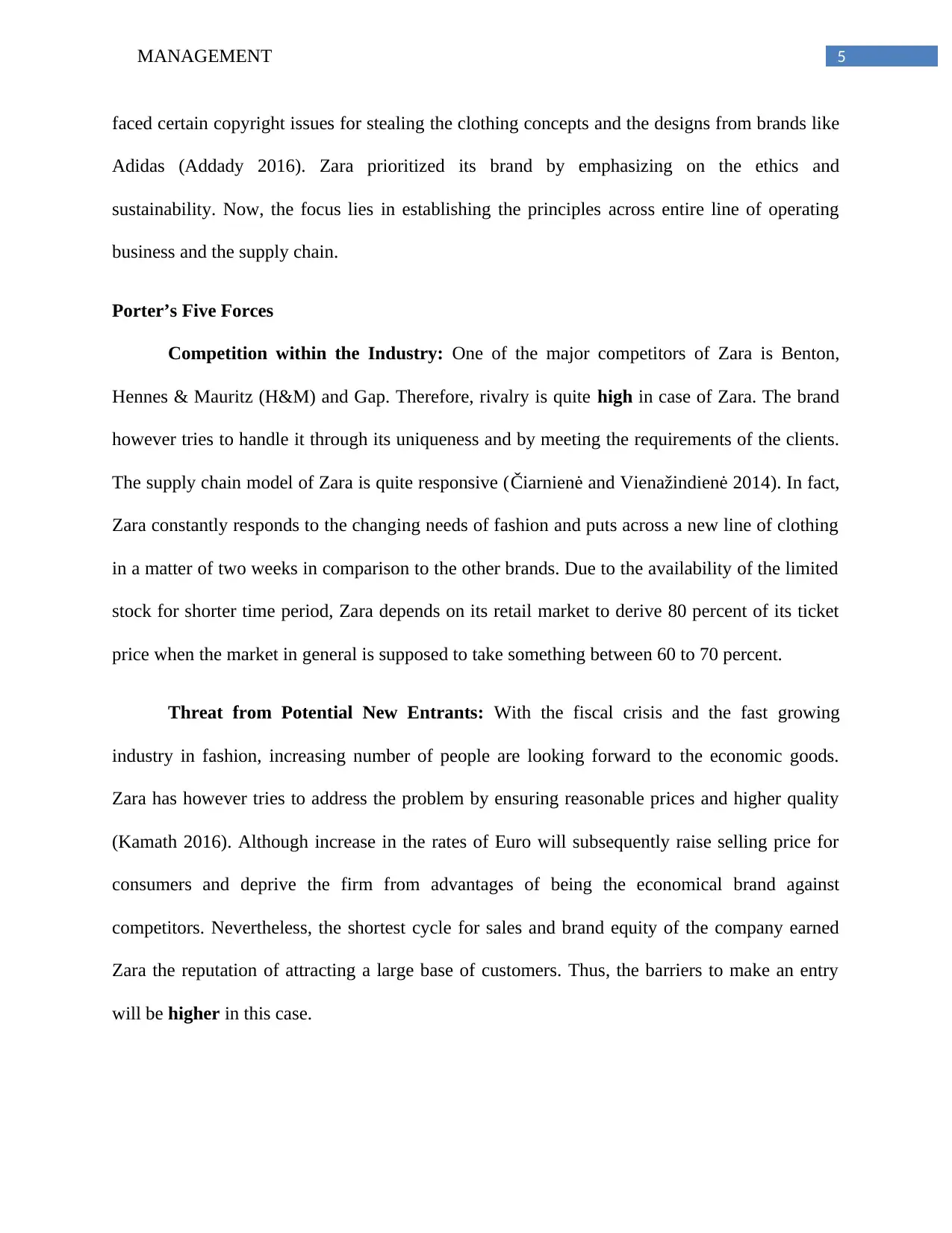
5MANAGEMENT
faced certain copyright issues for stealing the clothing concepts and the designs from brands like
Adidas (Addady 2016). Zara prioritized its brand by emphasizing on the ethics and
sustainability. Now, the focus lies in establishing the principles across entire line of operating
business and the supply chain.
Porter’s Five Forces
Competition within the Industry: One of the major competitors of Zara is Benton,
Hennes & Mauritz (H&M) and Gap. Therefore, rivalry is quite high in case of Zara. The brand
however tries to handle it through its uniqueness and by meeting the requirements of the clients.
The supply chain model of Zara is quite responsive (Čiarnienė and Vienažindienė 2014). In fact,
Zara constantly responds to the changing needs of fashion and puts across a new line of clothing
in a matter of two weeks in comparison to the other brands. Due to the availability of the limited
stock for shorter time period, Zara depends on its retail market to derive 80 percent of its ticket
price when the market in general is supposed to take something between 60 to 70 percent.
Threat from Potential New Entrants: With the fiscal crisis and the fast growing
industry in fashion, increasing number of people are looking forward to the economic goods.
Zara has however tries to address the problem by ensuring reasonable prices and higher quality
(Kamath 2016). Although increase in the rates of Euro will subsequently raise selling price for
consumers and deprive the firm from advantages of being the economical brand against
competitors. Nevertheless, the shortest cycle for sales and brand equity of the company earned
Zara the reputation of attracting a large base of customers. Thus, the barriers to make an entry
will be higher in this case.
faced certain copyright issues for stealing the clothing concepts and the designs from brands like
Adidas (Addady 2016). Zara prioritized its brand by emphasizing on the ethics and
sustainability. Now, the focus lies in establishing the principles across entire line of operating
business and the supply chain.
Porter’s Five Forces
Competition within the Industry: One of the major competitors of Zara is Benton,
Hennes & Mauritz (H&M) and Gap. Therefore, rivalry is quite high in case of Zara. The brand
however tries to handle it through its uniqueness and by meeting the requirements of the clients.
The supply chain model of Zara is quite responsive (Čiarnienė and Vienažindienė 2014). In fact,
Zara constantly responds to the changing needs of fashion and puts across a new line of clothing
in a matter of two weeks in comparison to the other brands. Due to the availability of the limited
stock for shorter time period, Zara depends on its retail market to derive 80 percent of its ticket
price when the market in general is supposed to take something between 60 to 70 percent.
Threat from Potential New Entrants: With the fiscal crisis and the fast growing
industry in fashion, increasing number of people are looking forward to the economic goods.
Zara has however tries to address the problem by ensuring reasonable prices and higher quality
(Kamath 2016). Although increase in the rates of Euro will subsequently raise selling price for
consumers and deprive the firm from advantages of being the economical brand against
competitors. Nevertheless, the shortest cycle for sales and brand equity of the company earned
Zara the reputation of attracting a large base of customers. Thus, the barriers to make an entry
will be higher in this case.
⊘ This is a preview!⊘
Do you want full access?
Subscribe today to unlock all pages.

Trusted by 1+ million students worldwide
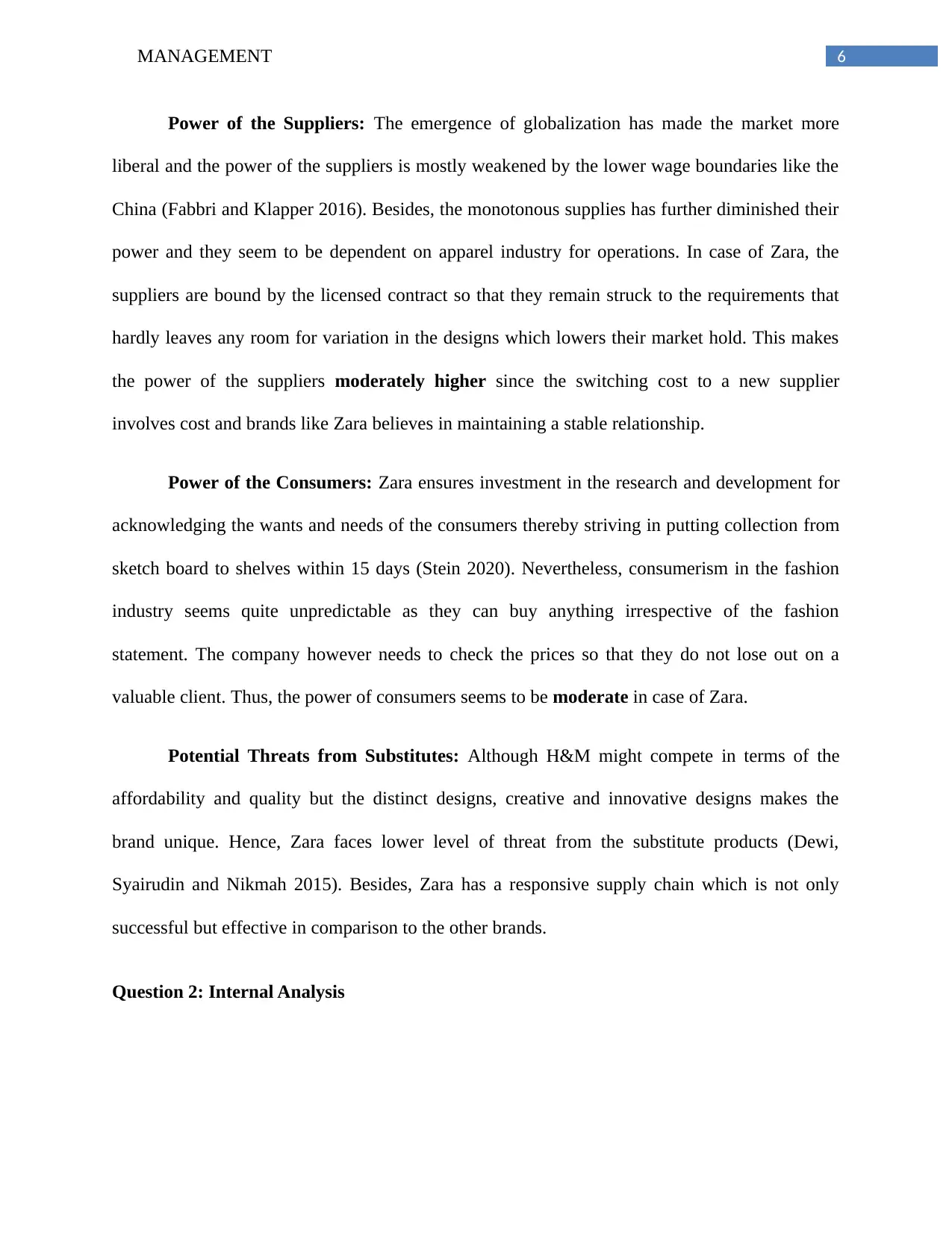
6MANAGEMENT
Power of the Suppliers: The emergence of globalization has made the market more
liberal and the power of the suppliers is mostly weakened by the lower wage boundaries like the
China (Fabbri and Klapper 2016). Besides, the monotonous supplies has further diminished their
power and they seem to be dependent on apparel industry for operations. In case of Zara, the
suppliers are bound by the licensed contract so that they remain struck to the requirements that
hardly leaves any room for variation in the designs which lowers their market hold. This makes
the power of the suppliers moderately higher since the switching cost to a new supplier
involves cost and brands like Zara believes in maintaining a stable relationship.
Power of the Consumers: Zara ensures investment in the research and development for
acknowledging the wants and needs of the consumers thereby striving in putting collection from
sketch board to shelves within 15 days (Stein 2020). Nevertheless, consumerism in the fashion
industry seems quite unpredictable as they can buy anything irrespective of the fashion
statement. The company however needs to check the prices so that they do not lose out on a
valuable client. Thus, the power of consumers seems to be moderate in case of Zara.
Potential Threats from Substitutes: Although H&M might compete in terms of the
affordability and quality but the distinct designs, creative and innovative designs makes the
brand unique. Hence, Zara faces lower level of threat from the substitute products (Dewi,
Syairudin and Nikmah 2015). Besides, Zara has a responsive supply chain which is not only
successful but effective in comparison to the other brands.
Question 2: Internal Analysis
Power of the Suppliers: The emergence of globalization has made the market more
liberal and the power of the suppliers is mostly weakened by the lower wage boundaries like the
China (Fabbri and Klapper 2016). Besides, the monotonous supplies has further diminished their
power and they seem to be dependent on apparel industry for operations. In case of Zara, the
suppliers are bound by the licensed contract so that they remain struck to the requirements that
hardly leaves any room for variation in the designs which lowers their market hold. This makes
the power of the suppliers moderately higher since the switching cost to a new supplier
involves cost and brands like Zara believes in maintaining a stable relationship.
Power of the Consumers: Zara ensures investment in the research and development for
acknowledging the wants and needs of the consumers thereby striving in putting collection from
sketch board to shelves within 15 days (Stein 2020). Nevertheless, consumerism in the fashion
industry seems quite unpredictable as they can buy anything irrespective of the fashion
statement. The company however needs to check the prices so that they do not lose out on a
valuable client. Thus, the power of consumers seems to be moderate in case of Zara.
Potential Threats from Substitutes: Although H&M might compete in terms of the
affordability and quality but the distinct designs, creative and innovative designs makes the
brand unique. Hence, Zara faces lower level of threat from the substitute products (Dewi,
Syairudin and Nikmah 2015). Besides, Zara has a responsive supply chain which is not only
successful but effective in comparison to the other brands.
Question 2: Internal Analysis
Paraphrase This Document
Need a fresh take? Get an instant paraphrase of this document with our AI Paraphraser
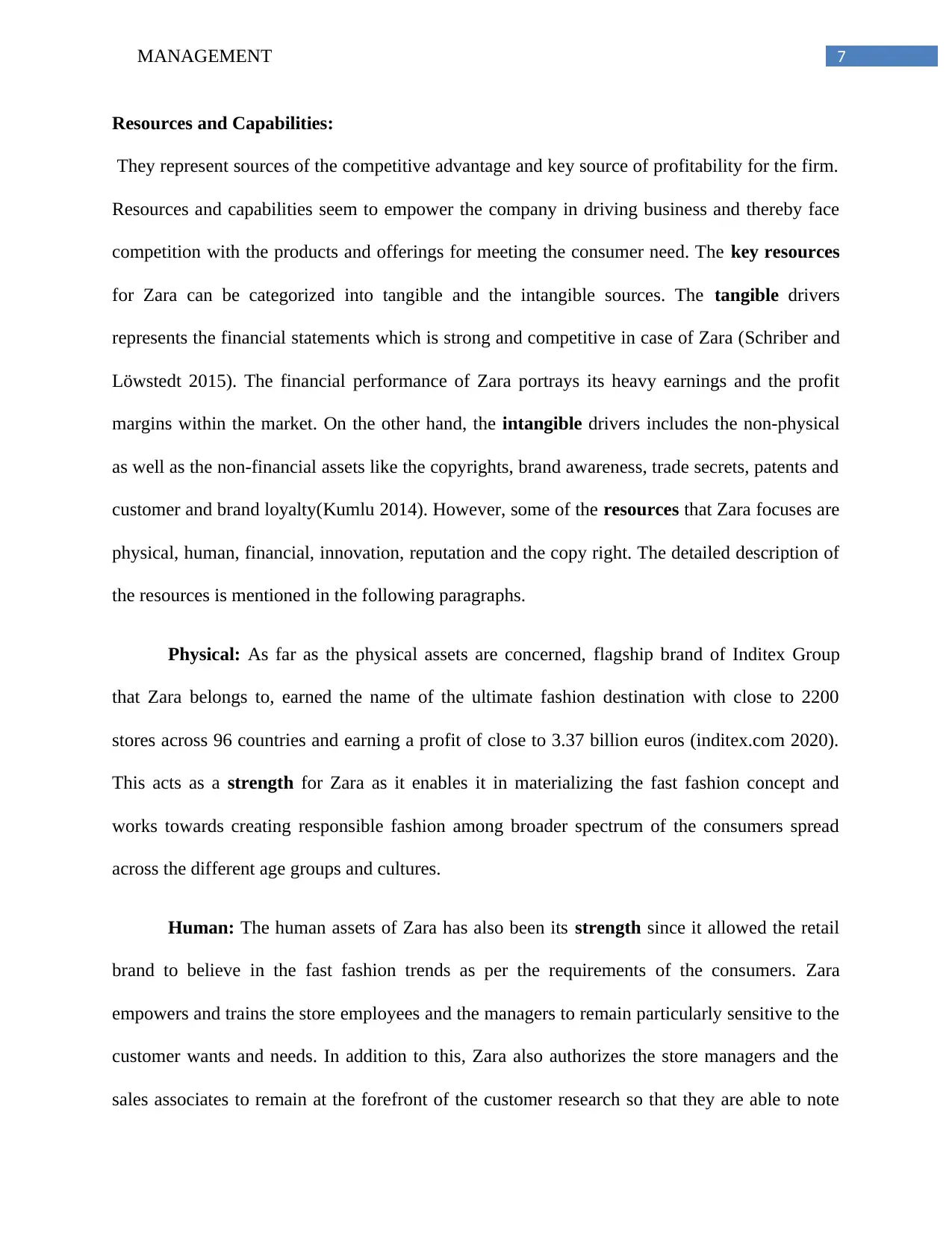
7MANAGEMENT
Resources and Capabilities:
They represent sources of the competitive advantage and key source of profitability for the firm.
Resources and capabilities seem to empower the company in driving business and thereby face
competition with the products and offerings for meeting the consumer need. The key resources
for Zara can be categorized into tangible and the intangible sources. The tangible drivers
represents the financial statements which is strong and competitive in case of Zara (Schriber and
Löwstedt 2015). The financial performance of Zara portrays its heavy earnings and the profit
margins within the market. On the other hand, the intangible drivers includes the non-physical
as well as the non-financial assets like the copyrights, brand awareness, trade secrets, patents and
customer and brand loyalty(Kumlu 2014). However, some of the resources that Zara focuses are
physical, human, financial, innovation, reputation and the copy right. The detailed description of
the resources is mentioned in the following paragraphs.
Physical: As far as the physical assets are concerned, flagship brand of Inditex Group
that Zara belongs to, earned the name of the ultimate fashion destination with close to 2200
stores across 96 countries and earning a profit of close to 3.37 billion euros (inditex.com 2020).
This acts as a strength for Zara as it enables it in materializing the fast fashion concept and
works towards creating responsible fashion among broader spectrum of the consumers spread
across the different age groups and cultures.
Human: The human assets of Zara has also been its strength since it allowed the retail
brand to believe in the fast fashion trends as per the requirements of the consumers. Zara
empowers and trains the store employees and the managers to remain particularly sensitive to the
customer wants and needs. In addition to this, Zara also authorizes the store managers and the
sales associates to remain at the forefront of the customer research so that they are able to note
Resources and Capabilities:
They represent sources of the competitive advantage and key source of profitability for the firm.
Resources and capabilities seem to empower the company in driving business and thereby face
competition with the products and offerings for meeting the consumer need. The key resources
for Zara can be categorized into tangible and the intangible sources. The tangible drivers
represents the financial statements which is strong and competitive in case of Zara (Schriber and
Löwstedt 2015). The financial performance of Zara portrays its heavy earnings and the profit
margins within the market. On the other hand, the intangible drivers includes the non-physical
as well as the non-financial assets like the copyrights, brand awareness, trade secrets, patents and
customer and brand loyalty(Kumlu 2014). However, some of the resources that Zara focuses are
physical, human, financial, innovation, reputation and the copy right. The detailed description of
the resources is mentioned in the following paragraphs.
Physical: As far as the physical assets are concerned, flagship brand of Inditex Group
that Zara belongs to, earned the name of the ultimate fashion destination with close to 2200
stores across 96 countries and earning a profit of close to 3.37 billion euros (inditex.com 2020).
This acts as a strength for Zara as it enables it in materializing the fast fashion concept and
works towards creating responsible fashion among broader spectrum of the consumers spread
across the different age groups and cultures.
Human: The human assets of Zara has also been its strength since it allowed the retail
brand to believe in the fast fashion trends as per the requirements of the consumers. Zara
empowers and trains the store employees and the managers to remain particularly sensitive to the
customer wants and needs. In addition to this, Zara also authorizes the store managers and the
sales associates to remain at the forefront of the customer research so that they are able to note
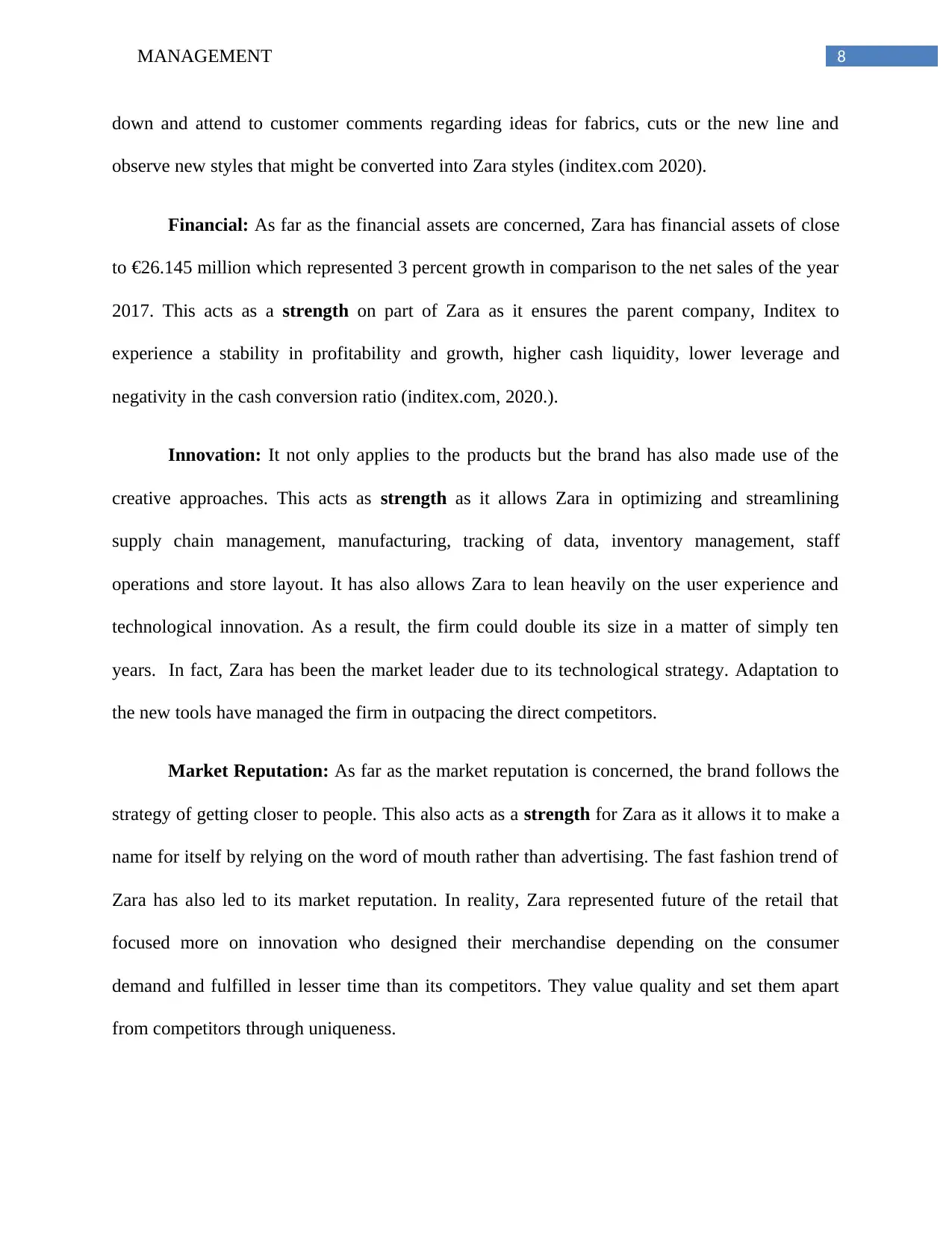
8MANAGEMENT
down and attend to customer comments regarding ideas for fabrics, cuts or the new line and
observe new styles that might be converted into Zara styles (inditex.com 2020).
Financial: As far as the financial assets are concerned, Zara has financial assets of close
to €26.145 million which represented 3 percent growth in comparison to the net sales of the year
2017. This acts as a strength on part of Zara as it ensures the parent company, Inditex to
experience a stability in profitability and growth, higher cash liquidity, lower leverage and
negativity in the cash conversion ratio (inditex.com, 2020.).
Innovation: It not only applies to the products but the brand has also made use of the
creative approaches. This acts as strength as it allows Zara in optimizing and streamlining
supply chain management, manufacturing, tracking of data, inventory management, staff
operations and store layout. It has also allows Zara to lean heavily on the user experience and
technological innovation. As a result, the firm could double its size in a matter of simply ten
years. In fact, Zara has been the market leader due to its technological strategy. Adaptation to
the new tools have managed the firm in outpacing the direct competitors.
Market Reputation: As far as the market reputation is concerned, the brand follows the
strategy of getting closer to people. This also acts as a strength for Zara as it allows it to make a
name for itself by relying on the word of mouth rather than advertising. The fast fashion trend of
Zara has also led to its market reputation. In reality, Zara represented future of the retail that
focused more on innovation who designed their merchandise depending on the consumer
demand and fulfilled in lesser time than its competitors. They value quality and set them apart
from competitors through uniqueness.
down and attend to customer comments regarding ideas for fabrics, cuts or the new line and
observe new styles that might be converted into Zara styles (inditex.com 2020).
Financial: As far as the financial assets are concerned, Zara has financial assets of close
to €26.145 million which represented 3 percent growth in comparison to the net sales of the year
2017. This acts as a strength on part of Zara as it ensures the parent company, Inditex to
experience a stability in profitability and growth, higher cash liquidity, lower leverage and
negativity in the cash conversion ratio (inditex.com, 2020.).
Innovation: It not only applies to the products but the brand has also made use of the
creative approaches. This acts as strength as it allows Zara in optimizing and streamlining
supply chain management, manufacturing, tracking of data, inventory management, staff
operations and store layout. It has also allows Zara to lean heavily on the user experience and
technological innovation. As a result, the firm could double its size in a matter of simply ten
years. In fact, Zara has been the market leader due to its technological strategy. Adaptation to
the new tools have managed the firm in outpacing the direct competitors.
Market Reputation: As far as the market reputation is concerned, the brand follows the
strategy of getting closer to people. This also acts as a strength for Zara as it allows it to make a
name for itself by relying on the word of mouth rather than advertising. The fast fashion trend of
Zara has also led to its market reputation. In reality, Zara represented future of the retail that
focused more on innovation who designed their merchandise depending on the consumer
demand and fulfilled in lesser time than its competitors. They value quality and set them apart
from competitors through uniqueness.
⊘ This is a preview!⊘
Do you want full access?
Subscribe today to unlock all pages.

Trusted by 1+ million students worldwide
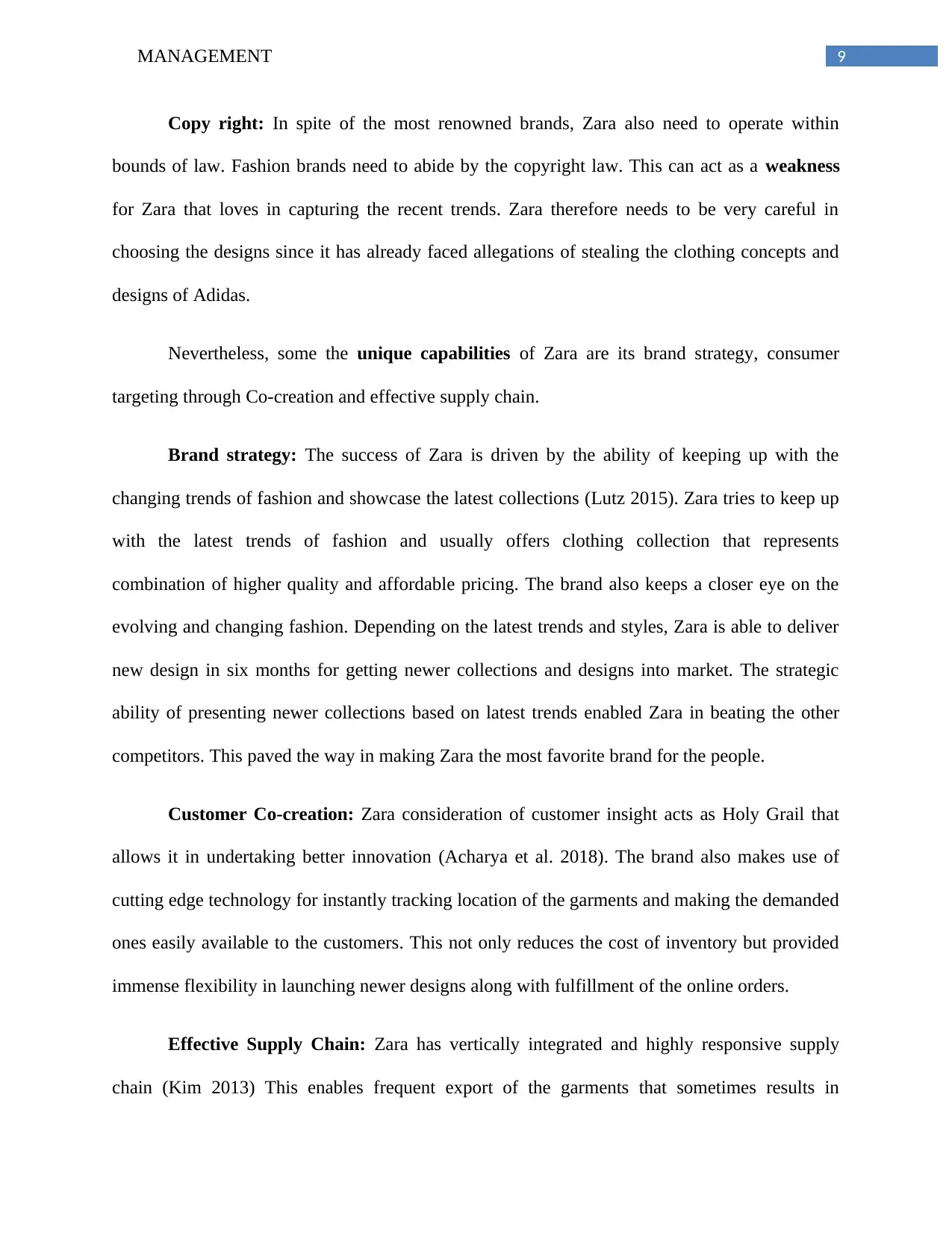
9MANAGEMENT
Copy right: In spite of the most renowned brands, Zara also need to operate within
bounds of law. Fashion brands need to abide by the copyright law. This can act as a weakness
for Zara that loves in capturing the recent trends. Zara therefore needs to be very careful in
choosing the designs since it has already faced allegations of stealing the clothing concepts and
designs of Adidas.
Nevertheless, some the unique capabilities of Zara are its brand strategy, consumer
targeting through Co-creation and effective supply chain.
Brand strategy: The success of Zara is driven by the ability of keeping up with the
changing trends of fashion and showcase the latest collections (Lutz 2015). Zara tries to keep up
with the latest trends of fashion and usually offers clothing collection that represents
combination of higher quality and affordable pricing. The brand also keeps a closer eye on the
evolving and changing fashion. Depending on the latest trends and styles, Zara is able to deliver
new design in six months for getting newer collections and designs into market. The strategic
ability of presenting newer collections based on latest trends enabled Zara in beating the other
competitors. This paved the way in making Zara the most favorite brand for the people.
Customer Co-creation: Zara consideration of customer insight acts as Holy Grail that
allows it in undertaking better innovation (Acharya et al. 2018). The brand also makes use of
cutting edge technology for instantly tracking location of the garments and making the demanded
ones easily available to the customers. This not only reduces the cost of inventory but provided
immense flexibility in launching newer designs along with fulfillment of the online orders.
Effective Supply Chain: Zara has vertically integrated and highly responsive supply
chain (Kim 2013) This enables frequent export of the garments that sometimes results in
Copy right: In spite of the most renowned brands, Zara also need to operate within
bounds of law. Fashion brands need to abide by the copyright law. This can act as a weakness
for Zara that loves in capturing the recent trends. Zara therefore needs to be very careful in
choosing the designs since it has already faced allegations of stealing the clothing concepts and
designs of Adidas.
Nevertheless, some the unique capabilities of Zara are its brand strategy, consumer
targeting through Co-creation and effective supply chain.
Brand strategy: The success of Zara is driven by the ability of keeping up with the
changing trends of fashion and showcase the latest collections (Lutz 2015). Zara tries to keep up
with the latest trends of fashion and usually offers clothing collection that represents
combination of higher quality and affordable pricing. The brand also keeps a closer eye on the
evolving and changing fashion. Depending on the latest trends and styles, Zara is able to deliver
new design in six months for getting newer collections and designs into market. The strategic
ability of presenting newer collections based on latest trends enabled Zara in beating the other
competitors. This paved the way in making Zara the most favorite brand for the people.
Customer Co-creation: Zara consideration of customer insight acts as Holy Grail that
allows it in undertaking better innovation (Acharya et al. 2018). The brand also makes use of
cutting edge technology for instantly tracking location of the garments and making the demanded
ones easily available to the customers. This not only reduces the cost of inventory but provided
immense flexibility in launching newer designs along with fulfillment of the online orders.
Effective Supply Chain: Zara has vertically integrated and highly responsive supply
chain (Kim 2013) This enables frequent export of the garments that sometimes results in
Paraphrase This Document
Need a fresh take? Get an instant paraphrase of this document with our AI Paraphraser
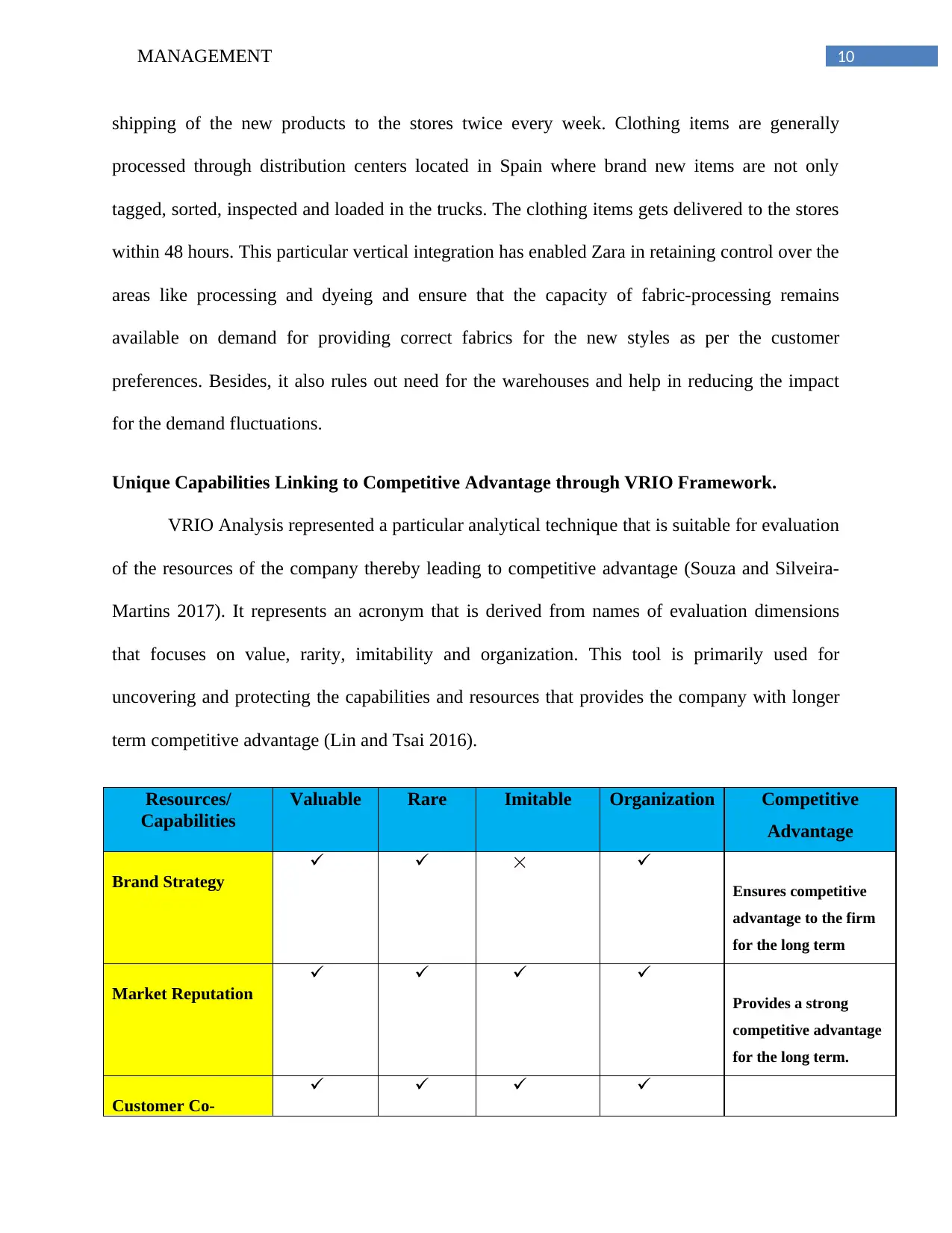
10MANAGEMENT
shipping of the new products to the stores twice every week. Clothing items are generally
processed through distribution centers located in Spain where brand new items are not only
tagged, sorted, inspected and loaded in the trucks. The clothing items gets delivered to the stores
within 48 hours. This particular vertical integration has enabled Zara in retaining control over the
areas like processing and dyeing and ensure that the capacity of fabric-processing remains
available on demand for providing correct fabrics for the new styles as per the customer
preferences. Besides, it also rules out need for the warehouses and help in reducing the impact
for the demand fluctuations.
Unique Capabilities Linking to Competitive Advantage through VRIO Framework.
VRIO Analysis represented a particular analytical technique that is suitable for evaluation
of the resources of the company thereby leading to competitive advantage (Souza and Silveira-
Martins 2017). It represents an acronym that is derived from names of evaluation dimensions
that focuses on value, rarity, imitability and organization. This tool is primarily used for
uncovering and protecting the capabilities and resources that provides the company with longer
term competitive advantage (Lin and Tsai 2016).
Resources/
Capabilities
Valuable Rare Imitable Organization Competitive
Advantage
Brand Strategy
Ensures competitive
advantage to the firm
for the long term
Market Reputation
Provides a strong
competitive advantage
for the long term.
Customer Co-
shipping of the new products to the stores twice every week. Clothing items are generally
processed through distribution centers located in Spain where brand new items are not only
tagged, sorted, inspected and loaded in the trucks. The clothing items gets delivered to the stores
within 48 hours. This particular vertical integration has enabled Zara in retaining control over the
areas like processing and dyeing and ensure that the capacity of fabric-processing remains
available on demand for providing correct fabrics for the new styles as per the customer
preferences. Besides, it also rules out need for the warehouses and help in reducing the impact
for the demand fluctuations.
Unique Capabilities Linking to Competitive Advantage through VRIO Framework.
VRIO Analysis represented a particular analytical technique that is suitable for evaluation
of the resources of the company thereby leading to competitive advantage (Souza and Silveira-
Martins 2017). It represents an acronym that is derived from names of evaluation dimensions
that focuses on value, rarity, imitability and organization. This tool is primarily used for
uncovering and protecting the capabilities and resources that provides the company with longer
term competitive advantage (Lin and Tsai 2016).
Resources/
Capabilities
Valuable Rare Imitable Organization Competitive
Advantage
Brand Strategy
Ensures competitive
advantage to the firm
for the long term
Market Reputation
Provides a strong
competitive advantage
for the long term.
Customer Co-
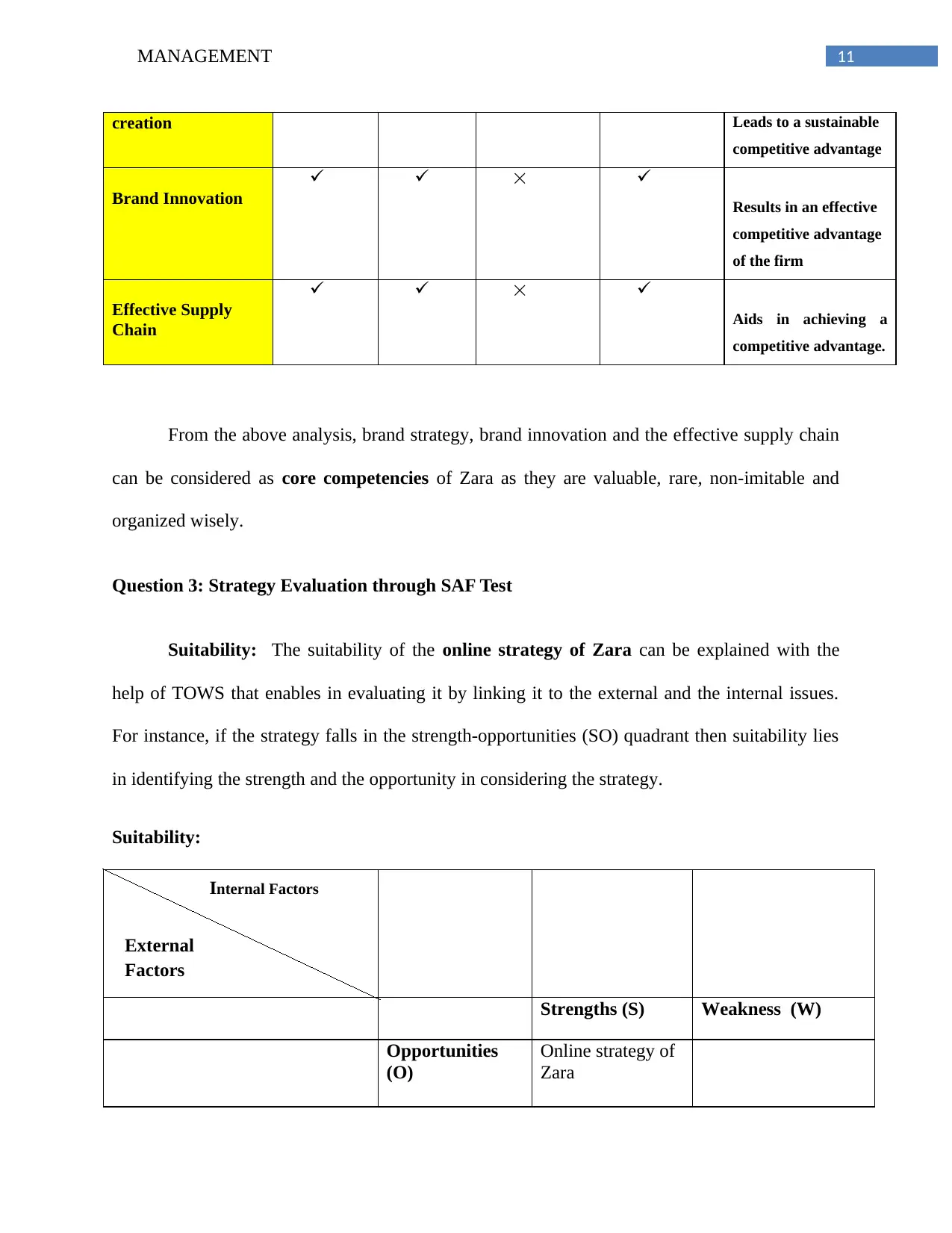
11MANAGEMENT
creation Leads to a sustainable
competitive advantage
Brand Innovation
Results in an effective
competitive advantage
of the firm
Effective Supply
Chain
Aids in achieving a
competitive advantage.
From the above analysis, brand strategy, brand innovation and the effective supply chain
can be considered as core competencies of Zara as they are valuable, rare, non-imitable and
organized wisely.
Question 3: Strategy Evaluation through SAF Test
Suitability: The suitability of the online strategy of Zara can be explained with the
help of TOWS that enables in evaluating it by linking it to the external and the internal issues.
For instance, if the strategy falls in the strength-opportunities (SO) quadrant then suitability lies
in identifying the strength and the opportunity in considering the strategy.
Suitability:
Strengths (S) Weakness (W)
Opportunities
(O)
Online strategy of
Zara
Internal Factors
External
Factors
creation Leads to a sustainable
competitive advantage
Brand Innovation
Results in an effective
competitive advantage
of the firm
Effective Supply
Chain
Aids in achieving a
competitive advantage.
From the above analysis, brand strategy, brand innovation and the effective supply chain
can be considered as core competencies of Zara as they are valuable, rare, non-imitable and
organized wisely.
Question 3: Strategy Evaluation through SAF Test
Suitability: The suitability of the online strategy of Zara can be explained with the
help of TOWS that enables in evaluating it by linking it to the external and the internal issues.
For instance, if the strategy falls in the strength-opportunities (SO) quadrant then suitability lies
in identifying the strength and the opportunity in considering the strategy.
Suitability:
Strengths (S) Weakness (W)
Opportunities
(O)
Online strategy of
Zara
Internal Factors
External
Factors
⊘ This is a preview!⊘
Do you want full access?
Subscribe today to unlock all pages.

Trusted by 1+ million students worldwide
1 out of 19
Related Documents
Your All-in-One AI-Powered Toolkit for Academic Success.
+13062052269
info@desklib.com
Available 24*7 on WhatsApp / Email
![[object Object]](/_next/static/media/star-bottom.7253800d.svg)
Unlock your academic potential
Copyright © 2020–2025 A2Z Services. All Rights Reserved. Developed and managed by ZUCOL.





